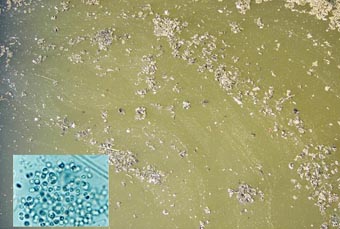
The study is included in an international project (SALGA) that analyzes the effect of climate change in shallow lakes located in the north of Europe and in the south of South America. The study has been recently published in the journals Global Change Biology, Freshwater Biology and Environmental Monitoring and Assessment. It concludes with the need to provide at least, 200 cubic hectometres per year to the Albufera, the reduction of discharges and a systematic control of microalgae and toxins levels both in water and fauna of the Park.
The international study SALGA in which the University of Valencia has been involved, reports that the increase of the global temperature of the planet favours a higher percentage of microalgae known as cyanobacteria in the plankton of shallow lakes – the most numerous of the planet – and therefore, an increase of toxicity risk by cyanotoxins produced by this type of microalgae.
Researchers from the University of Valencia, led by the professor of Ecology Susana Romo, have focused their research on the Albufera Nature Park of Valencia. They have concluded that over the past 10 years there has been an increase of this type of toxic microalgae in the lake plankton. This situation has come about because of the high concentration of nutrients into the waters, and at the same time because of the increase of water residence time, due to the reduction in river flow and sufficient good quality water into the lake. This situation has been aggravated especially in the drier years.
SALGA project has counted on the participation of over 11 research centres from Europe and South America. It has been financed by the Dutch government, as well as several organizations such as the European Union and National Geographic. The subject of study of this project has been ecology and the climate effects on shallow lakes located between the north of Europe and the south of South America.
The researcher Susana Romo, from the Ecology Unit of the Department of Microbiology and Ecology of the Faculty of Biological Sciences, emphasises that toxins concentration present on microalgae goes to the chain food and it tends to accumulate in fauna (for example, fishes) that inhabits in the Albufera Natural Park.
Among the measures that scientists suggest in order to solve the problem of toxins concentration, it would be necessary, at least, 200 cubic hectometres of water per year to Albufera to prevent long residence times in water, which favour the proliferation of toxic alga.
Other measure recommended by university experts is the reduction of discharges and nutrients into Albufera waters until recommended concentrations (lower than 0,03-0,05 milligrams/litre of total phosphorus and 2 milligrams/litre of total nitrogen).
Similarly, a systematic control of cyanobacteria and toxins levels both in water and fauna of Albufera Natural Park will be necessary, especially with respect to bird and fish species, so that indicators lower until low environmental and human health levels of risk, in accordance with international certificate protocols.
In the case of Valencia, for this study some results have been obtained from other studies on wetlands such as el Prat de Cabanes-Torreblanca Nature Park and el Fondo d’Elx. However, the broad majority of research has been conducted in the Albufera Nature Reserve.
Spanish involvement in this study has been centred on the University of Valencia, specifically the Ecology Unit of the Department of Microbiology and Ecology, Faculty of Biological Sciences. The data provided have been obtained from a specific study on the Albufera of Valencia, between 2001-2002 and 2005-2008, conducted by the professor Susana Romo and Juan Soria and with the collaboration of the professor Francisca Fernández, of the Department of Biology of the Autonomous University of Madrid. In addition, twelve interns and associates have also participated in the project.
Bibliographic References:
- Romo, S., Soria, J., Fernández, F., Ouahid, Y. and Barón-Solá, A. (2012). Water residence time and the dynamics of toxic cyanobacteria. Freshwater Biology, doi:10.1111/j.1365-2427.2012.02734.x.
- Romo, S., Fernández, F., Ouahid, Y. and Barón-Solá, A. (2012). Assessment of microcystins in lake water and fish (Mugilidae, Liza sp.) in the largest Spanish coastal lake. Environmental Monitoring and Assessment 184: 939–949.
- Kosten S., Huszar V., Bécares E., Costa L., van Donk E., Hansson L.A., Jeppesen E., Kruk C., Lacerot G., Mazzeo N., Meester L., Moss B., Lürling M., Noges T., Romo S. and Scheffer M. (2012). Warmer climates boost cyanobacterial dominance in shallow lakes. Global Change Biology 18: 118-126.
- Romo, S., García-Murcia, A.; Villena, M. J., Sánchez V. & Ballester, A. (2008). Tendencias del fitoplancton en el lago de la Albufera de Valencia e implicaciones para su ecología, gestión y recuperación. Limnetica 27: 11-28.
- Romo, S., Villena, M.J., Sahuquillo, M., Soria, J., Giménez, M., Alfonso, T., Vicente E. and Miracle, R. (2005). Response of a shallow Mediterranean lake to nutrient diversion: does it follow similar patterns as in northern shallow lakes? Freshwater Biology 50: 1706-1717.
Last update: 5 de december de 2012 13:11.
News release



















